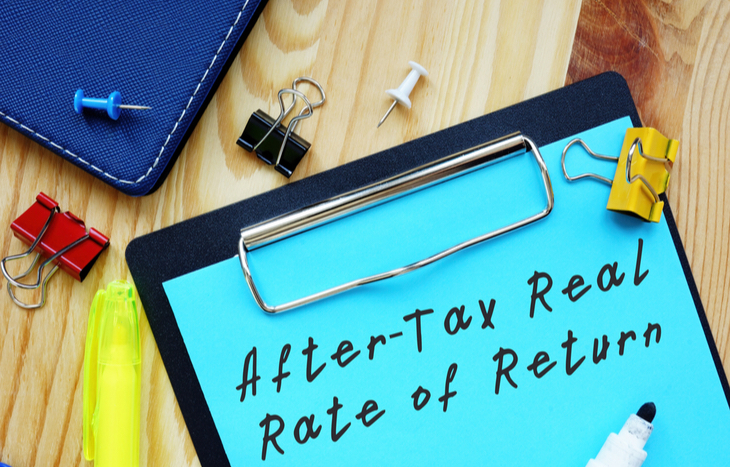What is the After-Tax Real Rate of Return?
It’s always nice to see positive gains in your portfolio. But what you’re looking at isn’t actually accurate—at least, not until you factor in taxes. What is the after-tax real rate of return for your investments? It’s an important question every investor needs to ask themselves. You might be surprised to learn that taxes (and time) can take a big chunk out of your ROI.
To understand the after-tax real rate of return, it’s important to see beyond the numbers in your portfolio. Instead, consider what happens after you exit your position and take your gains. Before that money goes into your pocket, Father Time and Uncle Sam will take their cut. What you’re left with is the after-tax amount, which you can use to calculate your after-tax real rate of return.

Factors Involved in After-Tax Real Rate of Return
Despite the name, there’s a lot more than tax to consider in the after-tax real rate of return. Really, this is a blanket term that covers any and all expenses that occur during profit-taking. Here’s a look at all the different factors you can expect to lose money to after you exit your position:
- Taxes. As soon as you exit a position and take profits, you’ll incur a taxable event. The amount you’re taxed comes out of the gross return on investment, and is part of the after-tax real rate of return.
- Inflation. Inflation varies year-over-year, but tends to hover somewhere between 1-3%. This means that every dollar you’ve invested in the principal is worth that much less. It’s important to factor in the loss when determining true ROI.
- Fees. Whether it’s the fund management fee or the expense ratio for an investment product, fees eat into gross ROI. Identifying these fees and their percentage means understanding how much in gains you’ve forgone.
- Opportunity cost. Every investment is a choice. If one company underperforms another in your portfolio, comparing their ROI creates an unrealized loss—opportunity cost. If ABC Company returned 12% and XYZ Company returned 16%, your opportunity cost is 4% because you would have invested more heavily in the latter.
These variables are extremely important to consider, because they can take a big bite out of anticipated returns. Take a look at an example:
Sabrina is ready to take profits from a managed fund that has gained 14% in the past year. However, the fund has a 1% management fee, which means her real returns are only 13%. Inflation over the past 12 months was 2%, shaving that ROI down to 11%. Finally, Sabrina will pay capital gains tax, which lowers her total return by another 2%, to 9%: her after-tax real rate of return.
Even for a high-performing investment, taxes, inflation, fees and more can bring down real returns by a staggering amount. This is why experienced investors consistently preach cognizance when considering real rate of return, not gross rate of return.
Positive and Negative Rates of Return
It’s possible to incur both positive and negative rates of return. Simply put, if your investment increases, you’ll have a positive rate of return. If you lose money, you’ll incur a negative rate of return. But there’s more to it than meets the eye for after-tax real rate of return.
For example, you might choose to invest in a corporate bond with a 3% rate. On the surface, it looks like you’ve locked in a positive rate of return—especially since there aren’t fees attached to bonds. But taxes and inflation may add up to 3%, effectively stomping your positive rate of return into a zero or negative rate! It can be deceiving.
Moreover, when you consider opportunity cost, the potential for a substandard rate of return becomes a concern. Say that the S&P 500 returns 15% over a five-year period. If, after accounting for taxes, fees and inflation, your investment in individual securities comes to 12%, you’ve achieved a positive rate of return… but you haven’t matched the market’s rate. It’s a frustrating conundrum for investors.
Tips to Improve After-Tax Real Rate of Return
If you want to make the most out of your real rate of return, it’s important to pay attention to the factors that affect it. Here are some simple tips on how to boost your after-tax rate of return:
- Always be mindful of taxes and fees when investing in managed products
- Choose low- or no-cost securities and funds when investing
- Offset capital gains with capital losses when taking profits, to reduce tax liability
- Longer time horizon equates to more compounding opportunities and a higher ROI
- Look for defensive investments designed to match the rate of inflation, at a minimum
- Calculate after-tax real rate of return when looking at historical ROI
Improving after-tax real rate of return starts with being mindful of the factors that affect it. Pay attention to the hidden costs of your investments, and take steps to plan for them, mitigate them and avoid them altogether.
Keep Real Rate of Return in Mind
It’s easy to get excited about market-beating numbers in your portfolio. As you seek to take profit or shift your investment, keep the real rate of return top-of-mind. What is the after-tax real rate of return? It’s what you’ll end up with after taxes, fees, inflation and other depreciating variables factor into the gross return. And while it might leave you with much less than you thought you had, that figure is true and accurate.
To keep your real rate of return high, take steps to mitigate all those unforeseen variables pulling it down. Avoid fees. Hedge inflation. Offset capital gains. Most importantly, invest with a mind for real returns, not just companies that pace the market. For the latest investment opportunities, sign up for the Proft Trends e-letter below. You may just find the next big market mover than enhaces your portfolio!





